-
收藏模板
- 模板信息
- 更新时间:2023-09-08
- 字数:约27814字
- 页数:约26页
- 格式:.doc
- 推荐版本:Office2016及以上版本
- 售价:5 金币
您可能喜欢的文档
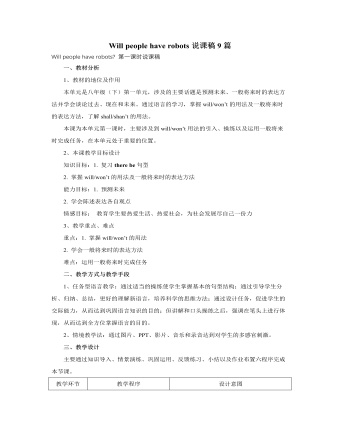
人教版新目标初中英语八年级下册Will people have robots说课稿9篇
(一) 导入新课(1’)运用多媒体课件,播放有关机器人的视频,引起学生共鸣,激发学生学习兴趣。 边看边展示与课文相关的新单词。让学生想像机器人都是什么样的,机器人能做什么?(这样导入新课,自然创设学习情景,引起学生共鸣,引起学生的兴趣。)(二)快速阅读(skimming)(4’)任务:让学生带着要求快速阅读课文:Get the main idea of the whole passage.这个环节是让学生初读课文,目的是训练快速阅读技巧,学生以较快的速度完成阅读,迅速找到答案。(学法指导:注意:用浏览、跳读和快读的技巧,培养自己快速获有用信息的能力---抓住关键词、主题句和中心大意的能力。Tips: Reading for meaning , not for details(细节).不必逐行阅读(三)深层阅读(5’)任务一:默读文章,回答下列问题,我利用多媒体出示2个问题,(把2个问题打出来)然后让学生带着问题进行有目的阅读。(这样做可以充分利用课本资源,而且化难为易.在全班校对答案之前我让学生先进行同桌相互校对,充分发挥生生互动。)
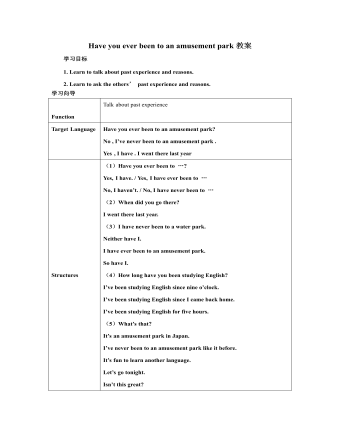
人教版新目标初中英语八年级下册Have you ever been to an amusement park教案
(1)Have you ever been to …? Yes, I have. / Yes, I have ever been to …No, I haven’t. / No, I have never been to …(2)When did you go there? I went there last year. (3)I have never been to a water park. Neither have I. I have ever been to an amusement park. So have I. (4)How long have you been studying English? I’ve been studying English since nine o’clock. I’ve been studying English since I came back home. I’ve been studying English for five hours. (5)What’s that? It’s an amusement park in Japan. I’ve never been to an amusement park like it before. It’s fun to learn another language. Let’s go tonight. Isn’t this great?space museum, amusement park, water park, South America, Peru, Holland, European culture, tour guide, flight attendant, musical instrument, more than, be from, get to, take lessons, neither, discover, graduate, change
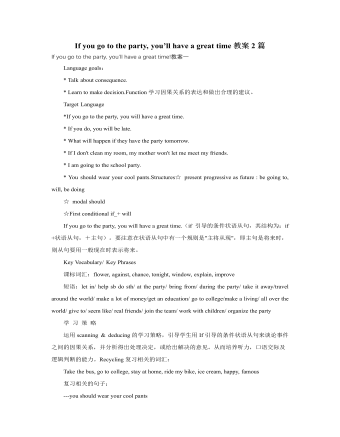
人教版新目标初中英语八年级下册If you go to the party, you’ll have a great time教案2篇
区分宾语从句、定于从句和状语从句宾语从句和状语从句,都叫做主从复合句。宾语从句主要是中考必考的,是初中阶段必掌握的从句,宾语从句主要是掌握三要素,所谓宾语从句,就是宾语在主从复合句当中充当宾语的一个句子,叫做宾语从句。主句的谓语动词是及物动词,后面如果是词或者是短语的话,是简单句,如果是句子的话,肯定是宾语从句。I know that he good at English.就是宾语从句,三要素,一要素是要注意连词,连词一共学了三类连词,一类连词是that口语当中可以省略,就像刚才说的那一句,I hear he is good at English.还有疑问代词、疑问副词,how where when,疑问代词、疑问副词。还有一类连词weather是否的意思,不是状语从句当中的如果,这一定要和如果区分开,这是是否。I don't know if he interested at English。宾语从句要注意if是连词。第二要素是语序,要用陈述举语序。比如说你家有几口人,我们都说How many people are there in you family?但是这是简单句,一旦说成宾语从句,你可以告诉我你家有几口人吗?Could you tell me how many people there are in you family ?
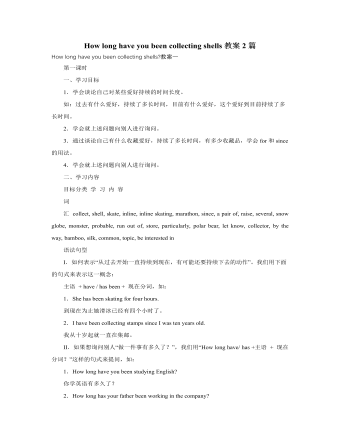
人教版新目标初中英语八年级下册How long have you been collecting shells教案2篇
Step Ⅱ Show the new words on the screen and teach the new words. Read the new words to students and ask them to repeat.Step Ⅲ 3aThis activity introduces new vocabulary and provides reading practice using the target language.In this activity first look at the four pictures.T: What can you see in the pictures?Ss: Four snow globes.T: Right. There are four snow globes in the pictures. And what are they?Ss: They are a monster, two polar bears, two penguins and a birthday cake.Write these words on the blackboard: snow globe; monster; polar bear; penguin and birthday cake. Read them to the class and ask students to repeat each one. Make sure students understand each word.Use a computer to show the E-mail message on the screen and read the message to students.Get students to read the e-mail on their own, and then draw lines connecting each snow globe and its description.Correct the answers.AnswersA line should connect each snow globe picture with the words that describe it in the letter.Step Ⅳ 3bThis activity provides writing practice using the target language.First review Activity 2a on Page 47.Then ask students to complete the message according to Activity 2a.Some partial sentences are given to students. Write about one person's collection.When students work, walk around the room checking the progress and offering help as needed.When they finish, ask some students to read their messages to the class.
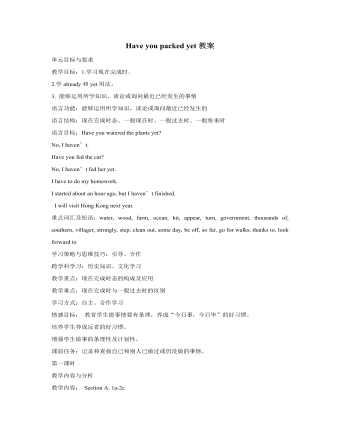
人教版新目标初中英语九年级下册Have you packed yet教案
教学目标:1.学习现在完成时。2.学already和yet用法。3. 能够运用所学知识,谈论或询问最近已经发生的事情语言功能:能够运用所学知识,谈论或询问最近已经发生的语言结构:现在完成时态、一般现在时、一般过去时、一般将来时语言目标:Have you watered the plants yet?No, I haven’t.Have you fed the cat?No, I haven’t fed her yet.I have to do my homework. I started about an hour ago, but I haven’t finished. I will visit Hong Kong next year.重点词汇及短语:water, wood, farm, ocean, hit, appear, turn, government, thousands of, southern, villager, strongly, step, clean out, some day, be off, so far, go for walks, thanks to, look forward to学习策略与思维技巧:引导、合作跨学科学习:历史知识、文化学习教学重点:现在完成时态的构成及应用教学难点:现在完成时与一般过去时的区别 学习方式:自主、合作学习 情感目标: 教育学生做事情要有条理,养成“今日事,今日毕”的好习惯。培养学生养成反省的好习惯。增强学生做事的条理性及计划性。课前任务:记录和查找自己和别人已做过或仍没做的事情。
- 查看更多相关Word文档
Will people have robots教案
Will people have robots?教案一
Teachinggoals:
1.Words&phrases:robot, paper, less, fewer, simple, unpleasant, factory, seem, etc .
2.will 构成的一般将来时态的陈述句、否定句、疑问句及回答.

3.There be 句型的一般将来时.
4.more , less , fewer 的用法.
5.学习一般将来时态的相关知识,学会对未来进行预测.
6.对five years ago ,today ,in five years 简洁回顾与展望的方式,贴近实际符合学生心理,激发学习兴趣.
7.通过时间对比复习一般过去时态、一般现在时态,巩固一般将来时.
Important and difficultpoints :
1.will构成一般将来时态的句式。
2.There be 句型的一般将来时态。
3.more , fewer , less 的用法。
4.How to makepredictions .
Period 1
Teaching procedures:
Step 1 Leading in
1.Greetings: Welcome toschool .
What’s the date today ? Who’s on duty today ?
Do you enjoy yourwinter holiday ?
Do you finish yourhomework ?
Do you want to live onthe moon ?
Can you guess what willhappen in ten years ?
Collect the Ss’ answers and say something about theirpredictions .
Step 2 Pre-task
SB Page 2 ,1a .
1.Look at the picture:How will the world be different in the future ,100 years from now ?We’re going to talk about sth in 100 years .
2.Read each predictionsto the class .Explain the new vocabulary .
3.Read the instructions.Make sure Ss know what they should do .
4.Do it by themselves .
5.Talk about theanswers with the class .
Explain :一般将来时态
构成: will / be going to +动词原形
Step 3 While-task
SB Page 2 ,1b .
1.Practise reading thesix predictions .
2.Read the instructionsto Ss .Circle the things you hear on the recording .
3.Play the tape twice .
4.Play the tape a thirdtime .At the same time ,check the answers .
SB Page 2 , 1c .
1.Pay attention to thedialogues .
2.Read the dialoguesfluently .
3.Pairwork .Work inpairs to make predictions according to the sample .
4.Ask several pairs toshare their conversations to the class .
SB Page 3 , 2a & 2b.
1.Read the predictions.
2.Read the instructionsand point out the sample answer .
3.Play the tape twice.Ss circle the word they hear in each sentences: more , less , fewer .
4.Check the answers .
学生探究: less , fewer 的区别。
Step 4 Post-task
1.Point to the examplein the sample dialogue .Practice reading .
2.Look at activity 2b.Groupwork:Take turns to make conversations about the predictions .
Grammar Focus:
1.Review the grammarbox .Ss say the statements and responses .
2.Make summaries about “will” ,“fewer” and “less” .
Homework:
1.Make predictionsabout yourself in 10 years .Write down 5 sentences .
2.Go over the new words.
教学后记:
Period 2
Teaching procedures :
Step 1 Leading in
1.Greetings and freetalk .
2.Check their homework:Ask two or three Ss to speak out what they wrote down .(教师作出适当的评价)
Step 2 Pre-task
1.Go over what welearnt yesterday .
2.通过三种时间的对比简略复习一般过去时与一般现在时。
Step 3 While-task
SB Page 4 , 3a .
1.Point to the threepicture and say :This is Sally .The first picture is Sally five years ago ,thesecond one is Sally now ,and the third one is Sally five years in the future .
2.Read the instructions.
3.Complete filling inthe blanks individually .
4.Check the answers .
5.Practise reading.Then ask some Ss read them out .
SB Page 4 , 3b .
1.Look at activity 3a.Make predictions about Sally .
2.Point to the examplein the sample dialogue .Ask two Ss to read the dialogue to the class .
3.Practise reading .
4.Pairwork .Make theirpredictions about Sally .
Step 4 Post-task
1.Write about yourself.
With the help of thesample of Sally .We can write sth about ourselves five years ago ,today and infive years .
2.Complete the workindividually .
3.Review the task .Aska few more Ss for answers .
Homework :
Draw a picture of thecity in 20 years .Describe it to the class .
教学后记:
Period 3
Teaching procedures :
Step 1 Leading in
1.Greetings .
2.Say yourselves :fiveyears ago , today and in five years .
3.Check the homework.
Step 2 Pre-task
SB Page 5 , 1a .
1.Look at the form andread the headings to the class .Make sure the Ss know what they mean .
2.Read the list ofseven words .Explain the new words .
3.Write each word inthe correct column .Check the answers.
SB Page 5 , 1b .
1.Read the wordsalready written on the chart .
2.Groupwork: Thinkabout what we learned before .Write some words in the chart above .Divide theclass into groups of four ,let them have a competition .
Step 3 While-task
SB Page 5 , 2a .
1.Look at the picturescarefully .Can you guess what we’ll listen ?Talk about them .
2.Read the instructions.We’ll listen to 3conversations .Number the pictures 1-3 .
3.Play the tape twice.Check the answers .
SB Page 5 , 2b .
This activity is easy,I think .For we know the conversations are talking about Alexis 10 years ago,today and in 10 years .
1.Read the instructions.
2.Pay attention to thesentences and the verbs in the box .
3.Play the tape andcorrect the answers .
Step 4 Post-task
1.Read the instructions.
2.Pairwork. One isAlexis, one is Joe .
3.Point out the examplein the sample dialogue .Read it to the Ss .
4.Talk about Joe’s life now , ten years ago and in ten years.
5.Ask some pairs of Ssto say their dialogues .
Homework:
1.Go over the words .
2.写一篇50个单词左右的小短文,预测与展望未来我们的学习和生活。
教学后记:
Period 4
Teaching procedures:
Step 1 Leading in
1.Greetings .
2.Ask two Ss to say sthabout Joe .
3.Check their homework.
Step 2 While-task
SB Page 6 , 3a .
1.Read the instructions.
2.Give Ss 3 minutes toread the passage , tick out the new words.
3.Explain the new wordsand practice reading .
4.Point out the chart.Read the column headings to the class .
5.Read the passageagain .Write words from her answers in the correct columns below .
6.Check the answers .
7.Practise reading .
SB Page 6 , 3b .Playinga game :Who write it ?
1.Ss write about theirlife in ten years on a piece of paper but don’t write names on the paper .
2.Put all the Ss’ papers together .
3.Take turns readingthe paper .The other Ss guess who wrote it .
Step 3 Post-task
SB Page 6 , Part 4 .
1.Read the questionsbelow .
2.Ask two Ss to readthe dialogue .
3.Answer the questions.
4.Pairwork. Get yourpartner’s answers .
5.Share a few Ss’ conversations .
Homework:
1.Finish selfcheck astheir homework .
2.Go over the words inthis unit .
教学后记:
Period 5
Teaching contents:
Reading :Do you thinkyou will have your own robot ?
Teaching procedures :
Step 1 Leading in
1.Greetings and freetalk .
2.If possible,draw arobot on the Bb or put up a picture of a robot.
Tell :What does it looklike ? What can it do ?
3.Tell your partnerwhat you know about robots .
Step 2 Pre-task
SB Page 8 , 1b .
1.Read the title of thepassage .
2.Look at the picturetogether .Ask a few Ss to describe What they see .
3.Read the words andphrases in the box .Practice reading the words .
4.Circle the words youthink you will read in the passage .
Step 3 While-task
SB Page 8 .
1.First let Ss scan thepassage for the main idea .
2.Explain something .
help sb with sth /dosth
do the same as …
make sb do sth
It takes /took /willtake …
3.Ask a fewcomprehension questions around the class .
4.Read the passage bythe Ss .
Step 4 Post-task
1.Go through thereading again .
How many words in 1bdid you correctly predict ?
2.Go over thestructures in SB Page 9 , 3b .
Make their ownsentences .
Homework:
1.To make sure the Ssunderstand the passage .and I want to know whether they’re careful in the class ,let Ss translatethe passage into Chinese .
2.Go over this unit .
3.Make their ownsentences .
4.What ways do youthink a robot will help you and your family in the future .Write your ideas .
Will people have robots?教案二
Will people have robots | ||
Ⅰ.Teaching aims | 1. Knowledge aims: ⑴.words: robot, paper, use , less, fewer, tree, building, space, fly, moon… ⑵ Conversation: A: Will people use money in 100 years? B: No, they won’t. Everything will be free. Will people live to be 200 years old? A: Yes, they will. | |
2. Ability aims: ⑴ Learn to talk about the future using will. ⑵ Learn to make predictions. | ||
3. Emotion aims:Learn to study hard. | ||
II. Main Points | 1.What do you think life will be like in 100 years? 2.Every home will have a robot. 3. Will kids go to school?No, they won’t. They’ll study at home. 4.There will be fewer trees. | |
III. Difficult points | There will be … | |
IV.TeachingMethod | Task-based teaching method | |
V. Teaching aids | Radio, pictures. | |
Procedures | ||||
Steps | Contents | Aims and Demands | ||
Warming up | 1. Greetings. 2. Free Talk. | Arouse the Ss’ interesting of learning and make a comfortable situation for the students. | ||
Pre-task | 1. Ask students to think about the life in the future , they may talk about it in Chinese when necessary. 2. Show the pictures of future and help the students to learn and talk. | Learn the key words. Enable the Ss learn to share the information in their groups. Lead in
| ||
Task 1 | 1. Teacher present the following sentences: T: Will people have robots at home? S: Yes, they will. T: Will kids go to school? S: No, they won’t . They will study at home. T: Will people live to be 200 years old ? S: Yes, they will. 2. Ask the Ss to make a list, What will be in the future. 3. Ask some students to report. | Present and master the main points and difficult points.
Enable the students to use the key sentences to finish the task.
| ||
Task 2 | 1. Present the sentence. There will be more/ less/ fewer people. Etc. 2.Ask Ss to discuss and do 2a. 3. Ask some students to report. | Learn to make predictions with There will be… Enable the students to use the key sentences to finish the task.. Master the main and difficult points. | ||
Task 3 | 1. Ask one students to talk about more the future and express their opinions. 2. Ss make a conversation. | Arouse the interestingand enable the Ss to predict and learn to work in groups. | ||
Post-task | 1. Students report the result. 2. Teacher appraise those who did well in class. | Encourage Ss to make progress. | ||
Summary | 1. Go over the key words. 2. Revise the main sentences such as: Will people have…? Every home will have a robot. There will be more/less/fewer… I agree./ I don’t agree. | Consolidate the knowledge of this unit. | ||
Homework | 1. Finish the exercises. 2. Image you are in 2080, what will your life be like? Please write them down. | 1. Strengthen the knowledge. 2. Enable the students to write with the key sentences they learned. | ||
Notes of this period |
| |||
| Contents on the Bb Will people have robots? 1. What do you think life will be like in 100 years?robot 2.Every home will have a robot.paper 3. Will kids go to school? No, they won’t. They’ll study at home.use 4.. There will be fewer trees. less tree | |||
Will people have robots | ||||
Ⅰ.Teaching aims | 4. Knowledge aims: ⑴.words: sun, earth, spaceship, space station, even, pollution… ⑵ Conversation: A: I think there will be more pollution. B: Well, I don’t agree. But I think there will be fewer trees. A: I agree. | |||
5. Ability aims: ⑴ Learn to talk about the future using will. ⑵ Learn to make predictions. | ||||
6. Emotion aims:Learn to study hard. | ||||
II. Main Points | 1. more, fewer, less. 2. will not = won’t 3. everything will be free. | |||
III. Difficult points | There will be … | |||
IV.TeachingMethod | Task-based teaching method | |||
V. Teaching aids | Radio, pictures. | |||
Procedures | ||||||||||||||||||||||
Steps | Contents | Aims and Demands | ||||||||||||||||||||
Warming up | 3. Greetings. 4. Free Talk. | Arouse the Ss’ interesting of learning and make a comfortable situation for the students. | ||||||||||||||||||||
Pre-task | 3. Compare the past, present, and the future. 4. Enable the Ss to talk about the future with will. 5. Image what your life will be like in the future. Get the Ss to talk in groups and write them down. | Learn the key words. Enable the Ss learn to image and work in groups. Lead in
| ||||||||||||||||||||
Task 1 | 4. Teacher present the following sentences: T: One hundred years ago, people wanted to fly to the sky. They wanted to fly to the moon. Now people can fly in the sky easily. We use rockets to send up the spaceship to the universe. We make the space station. People can live there. In 100 years time, people will live on the moon. … 5. Ask the Ss to image what will happen in the future. 6. Ask some students to report. | Enable the Ss to use will to talk about the future.
Enable the students to use the key sentences to finish the task.
| ||||||||||||||||||||
Task 2 | 1. Ss make a survey.
2. Ask some students to report. | Learn to use There will be… Enable the students to use the key sentences to finish the task..
| ||||||||||||||||||||
Task 3 | 3. Ask one students to talk about more the future and express their opinions. 4. Do 2c. Ss make a conversation. | Arouse the interestingand enable the Ss to predict and learn to work in groups. | ||||||||||||||||||||
Post-task | 3. Do some exercise. 4. Teacher appraise those who did well in class. | Enable the Ss to write. | ||||||||||||||||||||
Summary | 3. Go over the usages. 4. Revise the main sentences . | Consolidate the knowledge of this unit. | ||||||||||||||||||||
Homework | 3. Finish the exercises. 4. Write down your ideal life. What will your life be like in the future? | 3. Strengthen the knowledge. 4. Enable the students to write with the key sentences they learned. | ||||||||||||||||||||
Notes of this period |
| |||||||||||||||||||||
| Contents on the Bb Will people have robots?
1. There will be more people in the futurespaceship 2.There won’t be more cars.sun 3. There will be less pollution in the future.earth 4.. There will be fewer trees.moon even | |||||||||||||||||||||
Will people have robots | ||
Ⅰ.Teaching aims | 7. Knowledge aims: ⑴.words: pet, building, fall , parrot, go skating, be able to, dress… ⑵ Conversation: Five years ago, I was in primary school. Today I am in middle school. In five years I will be in college. | |
8. Ability aims: ⑴ Learn to talk about the past, present, and the future. ⑵ Learn to talk about future activities. | ||
9. Emotion aims:Learn to collect information. | ||
II. Main Points | 4. was, be, will be 5. played, plays, will play. 6. I think there will be more tall buildings. | |
III. Difficult points | I’ll= I will, they’ll= they will… | |
IV.TeachingMethod | Task-based teaching method | |
V. Teaching aids | Radio, pictures. | |
Procedures | ||||||||||||||||||
Steps | Contents | Aims and Demands | ||||||||||||||||
Warming up | 5. Greetings. 6. Free Talk. 7. Listening comprehension. | Arouse the Ss’ interesting of learning and revise the knowledge learned. | ||||||||||||||||
Pre-task | 6. Compare the past, present, and the future. 7. Enable the Ss to use the past indefinite tense, the present indefinite tense, the future tense . 8. Get the Ss to listen and repeat. | Learn the key words. Enable the Ss learn to talk about the past , the present , the future
Lead in
| ||||||||||||||||
Task 1 | 7. Teacher present the following sentences: Five years, I was. Today, I am . In five years, I will be. 8. Ask the Ss to talk about the past, present, and the future. 9. Ask some students to report. | Enable the Ss to use will to talk about the past, the present and the future.
Enable the students to use the key sentences to finish the task.
| ||||||||||||||||
Task 2 | 1. Ss make a survey.
2. Ask some students to report. | Learn to use the tense correctly. Enable the students to use the correct tense to finish the task..
| ||||||||||||||||
Task 3 | 5. Ask one students to talk about more about the future. 6. Do Section B. 1a. | Arouse the interestingand enable the Ss to summary and learn to work in groups. | ||||||||||||||||
Post-task | 5. Do Wb. Exx 1、2、3. 6. Check the answers. | Enable the Ss to write. | ||||||||||||||||
Summary | 5. Go over the usages. 6. Revise the main sentences . | Consolidate the knowledge of this unit. | ||||||||||||||||
Homework | 5. Finish exercise 4. 6. Recite the main dialogue of this unit. | 5. Strengthen the knowledge. 6. Enable the students to improve oral English | ||||||||||||||||
Notes of this period |
| |||||||||||||||||
| Contents on the Bb Will people have robots?
Five years ago,TodayIn five years (in the past)(now)(in the future) wasamwill be played playwill play hadhave will have worked work will work | |||||||||||||||||
Will people have robots | Feb.24 | |
Ⅰ.Teaching aims | 10. Knowledge aims: ⑴.words: fall in love with, as, lots of , apartment, keep a pet parrot, probably, be able to, dress, might, which,… ⑵ Language points: fall in love with, interesting/interested, alone/lonely, keep animals, be able to, even, might… | |
11. Ability aims: ⑴ Learn to talk about the past, present, and the future. ⑵ Learn the language points. (3) Learn to read the article of 3a. | ||
12. Emotion aims:Learn to express disagreement or agreement.. | ||
II. Main Points | 7. Language points 8. Talk about the past, present, and the future. 9. Talk about the life in ten years. | |
III. Difficult points | fall in love with, interesting/interested, alone/lonely, keep animals, be able to, even, might… | |
IV.Teaching Method | Task-based teaching method | |
V. Teaching aids | Radio, pictures. | |
Procedures | ||||||||||||||||||
Steps | Contents | Aims and Demands | ||||||||||||||||
Warming up | 8. Greetings. 9. Free Talk. 10. Check the answers of Wb. | Arouse the Ss’ interesting of learning and revise the knowledge learned. | ||||||||||||||||
Pre-task | 9. Talk about the life in ten years. 10. Enable the Ss to talk in groups. 11. Get the Ss to read the article of 3a. | Learn the key words. Enable the Ss learn to talk about the past , the present , the future
Lead in
| ||||||||||||||||
Task 1 | 1. Ss read 3a and finish the chart . 2. Ask the Ss to talk about the past, present, and the future. 3. Play a game, Ss write about their life in ten years on a piece of paper, then read it aloud. Try to guess who wrote it. | Enable the Ss to use will to read.
Enable the students to use the past tense and the future tense correctly
| ||||||||||||||||
Task 2 | 1. Ss answer the questions.
2. Ask some students to report. | Learn to use the tense in the interrogative sentence.
| ||||||||||||||||
Language points | 7. fall in love with, interesting/interested, alone/lonely, keep animals, be able to, even, might… 8. Which country will win …? | Learn the language points | ||||||||||||||||
Post-task | 7. Do Wb. Exx 4、5、6 8. Check the answers. | Enable the Ss to read and write. | ||||||||||||||||
Summary | 7. Go over the dialogue. 8. Revise the language points . | Consolidate the knowledge of this unit. | ||||||||||||||||
Homework | 7. Finish self check and the exercises in the Wb. 8. Revise the language points | 7. Strengthen the knowledge. 8. Enable the students to revise the grammar. | ||||||||||||||||
Notes of this period |
| |||||||||||||||||
| Contents on the Bb Will people have robots? 1. fall in love with sb.He fell in love with Marry. 2. lots of/ a lot ofThere are lots of people. 3. interesting/ interestedbe interested in 4. alone/lonelyThough I am alone, but I’m not lonely. 5. keep animalsDo you like keeping pets? 6. be able to I will be able to drive a spaceship in ten years. | |||||||||||||||||
Will people have robots | Feb.25 | |
Ⅰ.Teaching aims | 13. Knowledge aims: ⑴.words: unpleasant, scientist, however, hundreds of, already, factory, simple, such, everywhere, human, shape , snake, shape, possible, electric, seem, impossible, housework. ⑵ Language points: the same as, make …do…, to take…, to help do…, to help with… | |
14. Ability aims: ⑴ Learn the skills of reading: to predict what will be in the text. ⑵ Learn to cooperate. | ||
15. Emotion aims:Learn to share information with their partners. | ||
II. Main Points | 10. Language points 11. Talk about the different kind of usages of robots. 12. Try to use specific language structures. | |
III. Difficult points | the same as, make …do…, to take…, to help do…, to help with… | |
IV.Teaching Method | Task-based teaching method | |
V. Teaching aids | pictures. | |
Procedures | ||
Steps | Contents | Aims and Demands |
Warming up | 11. Greetings. 12. Free Talk. | Arouse the Ss’ interesting of learning and revise the knowledge learned. |
转载请注明出处!本文地址:
https://www.lfppt.com/worddetails_57877555.html最新课件教案文档
-

精选高中生期末评语
1、该生学习态度端正 ,能够积极配合老师 ,善于调动课堂气氛。 能够积极完成老师布置的任务。学习劲头足,听课又专注 ,做事更认 真 ,你是同学们学习的榜样。但是,成绩只代表昨天,并不能说明你 明天就一定也很优秀。所以,每个人都应该把成绩当作自己腾飞的起 点。2、 你不爱说话 ,但勤奋好学,诚实可爱;你做事踏实、认真、为 人忠厚 ,是一个品行端正、有上进心、有良好的道德修养的好学生。在学习上,积极、主动,能按时完成老师布置的作业,经过努力 ,各 科成绩都有明显进步,你有较强的思维能力和学习领悟力,学习也有 计划性,但在老师看来,你的潜力还没有完全发挥出来,学习上还要有持久的恒心和顽强的毅力。
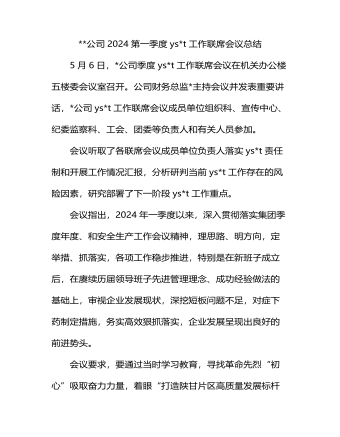
公司2024第一季度意识形态工作联席会议总结
一是要把好正确导向。严格落实主体责任,逐条逐项细化任务,层层传导压力。要抓实思想引领,把理论学习贯穿始终,全身心投入主题教育当中;把理论学习、调查研究、推动发展、检视整改等有机融合、一体推进;坚持学思用贯通、知信行统一,努力在以学铸魂、以学增智、以学正风、以学促干方面取得实实在在的成效。更加深刻领会到******主义思想的科学体系、核心要义、实践要求,进一步坚定了理想信念,锤炼了政治品格,增强了工作本领,要自觉运用的创新理论研究新情况、解决新问题,为西北矿业高质量发展作出贡献。二是要加强应急处事能力。认真组织开展好各类理论宣讲和文化活动,发挥好基层ys*t阵地作用,加强分析预警和应对处置能力,提高发现力、研判力、处置力,起到稳定和引导作用。要坚决唱响主旋律,为“打造陕甘片区高质量发展标杆矿井”、建设“七个一流”能源集团和“精优智特”新淄矿营造良好的舆论氛围。三是加强舆情的搜集及应对。加强职工群众热点问题的舆论引导,做好舆情的收集、分析和研判,把握时、度、效,重视网上和网下舆情应对。
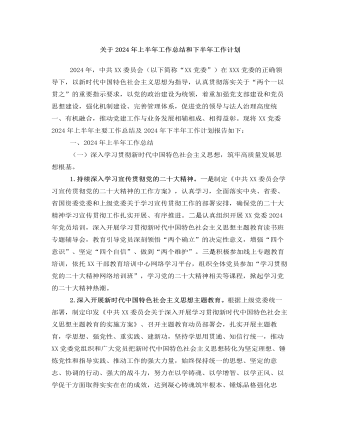
关于2024年上半年工作总结和下半年工作计划
二是深耕意识形态。加强意识形态、网络舆论阵地建设和管理,把握重大时间节点,科学分析研判意识形态领域情况,旗帜鲜明反对和抵制各种错误观点,有效防范处置风险隐患。积极响应和高效落实上级党委的决策部署,确保执行不偏向、不变通、不走样。(二)全面深化党的组织建设,锻造坚强有力的基层党组织。一是提高基层党组织建设力量。压实党建责任,从政治高度检视分析党建工作短板弱项,有针对性提出改进工作的思路和办法。持续优化党建考核评价体系。二是纵深推进基层党建,打造坚强战斗堡垒。创新实施党建工作模式,继续打造党建品牌,抓实“五强五化”党组织创建,广泛开展党员教育学习活动,以实际行动推动党建工作和经营发展目标同向、部署同步、工作同力。三是加强高素质专业化党员队伍管理。配齐配强支部党务工作者,把党务工作岗位作为培养锻炼干部的重要平台。
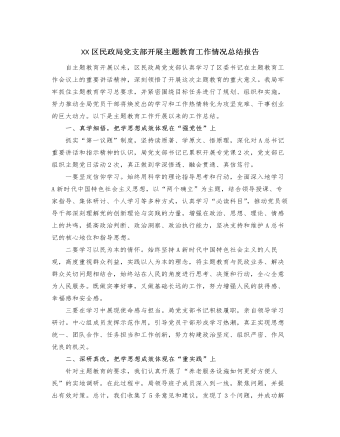
XX区民政局党支部开展主题教育工作情况总结报告
二要专注于解决问题。根据市委促进经济转型的总要求,聚焦“四个经济”和“双中心”的建设,深入了解基层科技工作、学术交流、组织建设等方面的实际情况,全面了解群众的真实需求,解决相关问题,并针对科技工作中存在的问题,采取实际措施,推动问题的实际解决。三要专注于急难愁盼问题。优化“民声热线”,推动解决一系列基层民生问题,努力将“民声热线”打造成主题教育的关键工具和展示平台。目前,“民声热线”已回应了群众的8个政策问题,并成功解决其中7个问题,真正使人民群众感受到了实质性的变化和效果。接下来,我局将继续深入学习主题教育的精神,借鉴其他单位的优秀经验和方法,以更高的要求、更严格的纪律、更实际的措施和更好的成果,不断深化主题教育的实施,展现新的风貌和活力。
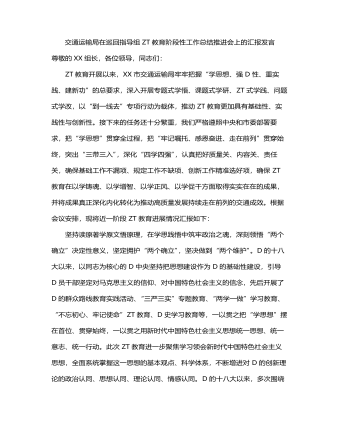
交通运输局在巡回指导组主题教育阶段性工作总结推进会上的汇报发言
今年3月,市政府出台《关于加快打造更具特色的“水运XX”的意见》,提出到2025年,“苏南运河全线达到准二级,实现2000吨级舶全天候畅行”。作为“水运XX”建设首战,谏壁闸一线闸扩容工程开工在即,但项目开工前还有许多实际问题亟需解决。结合“到一线去”专项行动,我们深入到谏壁闸一线,详细了解工程前期进展,实地察看谏壁闸周边环境和舶通航情况,不断完善施工设计方案。牢牢把握高质量发展这个首要任务,在学思践悟中开创建功之业,坚定扛起“走在前、挑大梁、多做贡献”的交通责任,奋力推动交通运输高质量发展持续走在前列。以学促干建新功,关键在推动高质量发展持续走在前列。新时代中国特色社会主义思想着重强调立足新发展阶段、贯彻新发展理念、构建新发展格局,推动高质量发展,提出了新发展阶段我国经济高质量发展要坚持的主线、重大战略目标、工作总基调和方法论等,深刻体现了这一思想的重要实践价值。
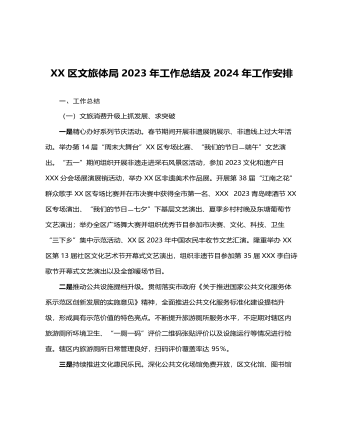
XX区文旅体局2023年工作总结 及2024年工作安排
三、2024年工作计划一是完善基层公共文化服务管理标准化模式,持续在公共文化服务精准化上探索创新,围绕群众需求,不断调整公共文化服务内容和形式,提升群众满意度。推进乡镇(街道)“114861”工程和农村文化“121616”工程,加大已开展活动的上传力度,确保年度目标任务按时保质保量完成。服务“双减”政策,持续做好校外培训机构审批工作,结合我区工作实际和文旅资源优势,进一步丰富我市义务教育阶段学生“双减”后的课外文化生活,推动“双减”政策走深走实。二是结合文旅产业融合发展示范区,全力推进全域旅游示范区创建,严格按照《国家全域旅游示范区验收标准》要求,极推动旅游产品全域布局、旅游要素全域配置、旅游设施全域优化、旅游产业全域覆盖。
今日更新Word
-

精选高中生期末评语
1、该生学习态度端正 ,能够积极配合老师 ,善于调动课堂气氛。 能够积极完成老师布置的任务。学习劲头足,听课又专注 ,做事更认 真 ,你是同学们学习的榜样。但是,成绩只代表昨天,并不能说明你 明天就一定也很优秀。所以,每个人都应该把成绩当作自己腾飞的起 点。2、 你不爱说话 ,但勤奋好学,诚实可爱;你做事踏实、认真、为 人忠厚 ,是一个品行端正、有上进心、有良好的道德修养的好学生。在学习上,积极、主动,能按时完成老师布置的作业,经过努力 ,各 科成绩都有明显进步,你有较强的思维能力和学习领悟力,学习也有 计划性,但在老师看来,你的潜力还没有完全发挥出来,学习上还要有持久的恒心和顽强的毅力。
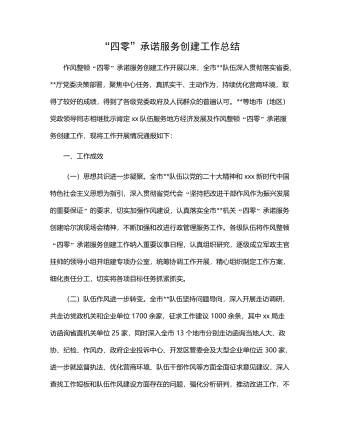
“四零”承诺服务创建工作总结
(二)坚持问题导向,持续改进工作。要继续在提高工作效率和服务质量上下功夫,积极学习借鉴其他部门及xx关于“四零”承诺服务创建工作的先进经验,同时主动查找并着力解决困扰企业和群众办事创业的难点问题。要进一步探索创新,继续优化工作流程,精简审批程序,缩短办事路径,压缩办理时限,深化政务公开,努力为企业当好“保姆”,为群众提供便利,不断适应新时代人民群众对政务服务的新需求。(三)深化内外宣传,树立良好形象。要深入挖掘并及时总结作风整顿“四零”承诺服务创建工作中形成的典型经验做法,进一步强化内部宣传与工作交流,推动全市创建工作质效整体提升。要面向社会和公众庄严承诺并积极践诺,主动接受监督,同时要依托电台、电视台、报纸及微信、微博等各类媒体大力宣传xx队伍作风整顿“四零”承诺服务创建工作成果,不断扩大社会知情面和群众知晓率。
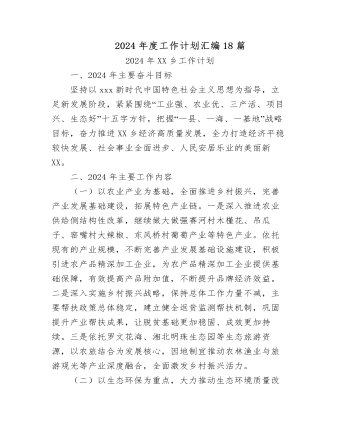
2024年度工作计划汇编(18篇)
1.市政基础设施项目5项,总建设里程2.13km,投资概算2.28亿元。其中,烔炀大道(涉铁)工程施工单位已进场,项目部基本建成,正在办理临时用地、用电及用水等相关工作;中铁佰和佰乐(巢湖)二期10KV外线工程已签订施工合同;黄麓镇健康路、纬四路新建工程均已完成清单初稿编制,亟需黄麓镇完成图审工作和健康路新建工程的前期证件办理;公安学院配套道路项目在黄麓镇完成围墙建设后即可进场施工。2.公益性建设项目6项,总建筑面积15.62万㎡,投资概算10.41亿元。其中,居巢区职业教育中心新建工程、巢湖市世纪新都小学扩建工程已完成施工、监理招标挂网,2月上旬完成全部招标工作;合肥职业技术学院大维修三期已完成招标工作,近期签订施工合同后组织进场施工;半汤疗养院净化和医用气体工程已完成招标工作;半汤疗养院智能化工程因投诉暂时中止;巢湖市中医院(中西医结合医院)新建工程正在按照既定计划推进,预计4月中下旬挂网招标。

驻村工作队2024年第一季度工作总结汇编(4篇)
三是做大做强海产品自主品牌。工作队于xx年指导成立的冬松村海产品合作社,通过与消费帮扶平台合作,在工作队各派出单位、社会团体、个人支持下,已获得逾xx万元销售额。2022年底工作队推动合作社海产品加工点扩建的工作方案已获批,待资金下拨后将正式启动扩建工作。四是积极助企纾困,带动群众增收致富。工作队利用去年建立的xx镇产业发展工作群,收集本地企业在产品销售、技术、人力、资金、运营、用地等方面的需求,并加大xx支持乡村振兴力度,xx助理赴各村委开展多场xx政策支持乡村振兴宣讲活动,本季度有x万元助农贷款获批,xx万贷款正在审批中。在壮大既有产业的同时,完善联农带农机制,一方面鼓励企业雇用本地农户就业,另一方面计划与本地农户签订长期收购合同,让农民种得放心、种得安心,带动当地群众共同致富。

主题教育总结常用提纲大全
第一,主题教育是一次思想作风的深刻洗礼,初心传统进一步得到回归。第二,主题教育是一次沉疴积弊的集中清扫,突出问题进一步得到整治。第三,主题教育是一次强化为民服务的生动实践,赤子之情进一步得到提振。第四,主题教育是一次激发创业担当的有利契机,发展层次进一步得到提升。2.第一,必须提领思想、武装思想。第二,必须聚焦问题、由表及里。第三,必须领导带头、以上率下。第四,必须务实求实、认真较真。3.一是抬高政治站位,坚持大事大抓。二是坚持思想领先,狠抓学习教育。三是突出问题导向,深入整改纠治。四是坚持领导带头,发挥表率作用。4.一是立足“早”字抓筹划。二是着眼“活”字抓学习。三是围绕“统”字抓协调。5.一是形势所需。二是任务所系。三是职责所在。四是制度所定。6.一要提升认识。二要积极作为。三要密切协作。
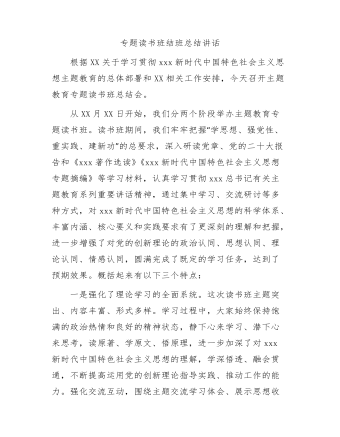
主题教育专题读书班结班总结讲话
第二,要把调查研究贯穿始终,实干担当促进发展。开展好“察实情、出实招”“破难题、促发展”“办实事、解民忧”专项行动,以强化理论学习指导发展实践,以深化调查研究推动解决发展难题。领导班子成员要每人牵头XX个课题开展调查研究,XX月底前召开调研成果交流会,集思广益研究对策措施。各部门、各单位要制定调研计划,通过座谈访谈、问卷调查、统计分析等方式开展调查研究,解决工作实际问题,帮助基层单位和客户解决实际困难。第三,要把检视问题贯穿始终,廉洁奉公树立新风。认真落实公司主题教育整改整治工作方案要求,坚持边学习、边对照、边检视、边整改,对标对表xxx新时代中国特色社会主义思想,深入查摆不足,系统梳理调查研究发现的问题、推动发展遇到的问题、群众反映强烈的问题,结合巡视巡察、审计和内外部监督检查发现的问题,形成问题清单。












